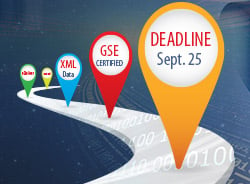Can a Single Platform Handle Both TRID & UCD?
Tanya Brennan of DocMagic provides insightful information on TRID and UCD readiness, and discusses how SmartCLOSE™, the company’s Collaborative Closing Portal, effectively addresses both TRID and the new UCD requirements.

 Join Tanya Brennan, DocMagic's eService Product Specialist, for a FREE educational webinar.
Join Tanya Brennan, DocMagic's eService Product Specialist, for a FREE educational webinar.  Join us for a Free DocMagic Webinar: Get Prepared for the UCD Requirement!
Join us for a Free DocMagic Webinar: Get Prepared for the UCD Requirement!  Press Release:
Press Release:  By Brian Hornea
By Brian Hornea Press Release:
Press Release: Industry experts weigh in on recent changes to Fannie Form 1003/Fredie Form 67.
Industry experts weigh in on recent changes to Fannie Form 1003/Fredie Form 67. New CFPB compliance requirements mandate that it's time for 'e.'
New CFPB compliance requirements mandate that it's time for 'e.' Press Release:
Press Release: Press Release:
Press Release: